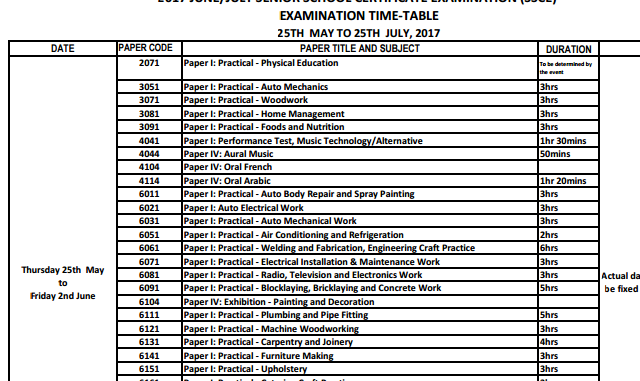
Nabteb Chemistry
CHEMISTRY OBJ
1AADDDCACCC
11DAACAABCDC
21ABABDCDCAC
31BDCCADBBBA
41DCDBDDDBAB
(1ai)
An element is a substance that cannot be split into simpler substances by any known chemical process.
(1aii)
Limestone ==> CaCo3
TABULATE
|Elements| Group|
UNDER ELEMENT:
(i) Calcium
(ii) Carbon
(iii) Oxygen
UNDER GROUP:
(i) II
(ii) IV
(iii) VI
(1bi)
Hund’s rule of maximum multiplicity states that every orbital in a subshell is singly occupied with one electron before any one orbital is doubly occupied and all electrons in singly occupied orbitals have the same spin
(1bii)
Carbon = 1s2 2s2 2p2
(1ci)
The outermost electrons are found in 4s and 3orbitals
(1cii)
Transition elements
(1ciii)
(i) It has variable oxidation states
(ii) It forms complex ions
(iii) It forms coloured compounds
(iv) It serves as catalyst
(1d)
The atoms in iron has valency of 2 in the 4s the atoms in the iron bar contribute their valent electrons to form pool or sea of electron. The repulsive forces of the electrons is balance by the electron cloud. The nuclear force emanating from the nucleus helps to keep the electron cloud in the lattice.
Fe(s) ==> Fe2 + 2e-
(2ai)
Electro negativity is the ability of an atom to attract electrons to itself when in a molecule
(2aii)
(i) P >AL>Na
(ii) P<AL<Na
(2bi)
Radioactivity is the spontaneous of emission of radiation and energy from an unstable isotope.
(2bii)
(i) 238U ==> 284Th + 4He + Energy
(ii) 214Pb ==> 214B2 +s
(iii) 14N + 4He ==> 19O + P + energy
(2c)
Fraction left after 30 days = (1/2)n
N = 30days/10days = 3
Fraction left after 30days = (1/2)3
= 1/8
Mass left after 30days = 1/8 x 20
= 2.5g
Mass that decayed off = (20 – 2.5)g
= 17.5g
(3ai)
Hygroscopy is the ability of a substance to absorb moisture from the atmosphere without dissolving in it to form a solution
(3aii)
(i) Conc H2SO4
(ii) Ethanol
(iii) Calcium oxide
(3bi)
M = I x t x m m/n x f
Ca + 2e- ==> Ca(s)
M = 10 x 3 x 60 x 40/2 x 96500
M = 72,000/193,400
M = 0.37g
(3bii)
TABULATE
||Electrolytic Cell || Electrochemical Cell|
UNDER ELECTROLYTIC CELL:
(i) It contains electrical energy chemical energy
(ii) The anode is positive while the cathode is negative
UNDER ELECTROCHEMICAL CELL:
(i) It convert chemical energy to electrical energy
(ii) The anode is negative electrode while the cathode is positive electrode
(3ci)
(i) Rhombic Sulphur
(ii) Monoclinic Sulphur
(3cii)
(1) It is used in industrial preparation of tetraoxosulphate (vi)
(2) It is used as fungicide
(3ciii)
H2S + Cl2 ==> 2HCL(g) + S(s)
(3civ)
(i) It is a reducing agent
(3v)
(i) Presence of air
(ii) Presence of moisture
(iii) Rusting can be prevented by coating the surface of the iron
(4ai)
DRAW THE DIAGRAM
Hydrochloric acid is added to the zinc granules in the flask and the gas produce is collected by downward displacement of air of water.
Zn(s) + 2HCL(aq) ==> Zncl2(aq) + H2(g)
(4aii)
TWO PHYSICAL PROPERTIES:
(i) It is colorless, odourless gas
(ii) It is neutral to litmus paper
TWO CHEMICAL PROPERTIES:
(i) It reacts with metal to form hydride
2Na + H2 ==> 2NaH
(ii) It burns in air to produce steam
2H2 + O2 ==> 2H2O
(4aiii)
(i) 3H ==> Trictium
(4b)
Permanent hardness of water is a water that contain dissolve MgSO4 or CaSO4 which makes it not to lather readily with soap
(4bii)
(i) MgSO4 ==> Magnessium tetraoxosulphate (vi)
(ii) CaSO4 ==> Calcium tetraoxosulphate (vi)
(4biii)
ADVATAGES:
(i) It makes to have taste
(ii) It helps to build strong bones and teeth
DISADVATAGES:
(i) It leads to wastage of soap
(ii) It cause fuming of kettles and boilers
(4biv)
Add a few drops of water to white anhydrous copper (ii) tetraoxosulphate (vi) it turns the salt blue
(4v)
(i) The state of matter of both the reactants and the products
(ii) The volume of reactants and products it gaseous
(iii) The reactant and the products involved
(5ai)
Homologous series is a family of organic compounds which follow a regular structure pattern in which each successive member differs in its molecular formula by a – CH2 group
(5aii)
(i) Successive members differ by –CH2
(ii) Members can be prepared by the same general methods
(iii) They have general formula
(5aiii)
H H CH3 H H
H – C – C – C – C – H
H H H CH3
2,3 – dimethylpentane
(5bi)
(i) Heat
(ii) Catalyst
(5bii)
C10H22 ==> C5H12 + C5H10
C5H10 ==> Pentene
(5c)
H H H H H H
H – C – C – C – C – C – H
H H H OH H
Pentan – 2 – 01
(5cii)
RCOOR2
(5ciii)
CH3CH2CH2COOH + CH3OH
CH3CH2CH2COOCH3
Methylbutanoate

Leave a Reply